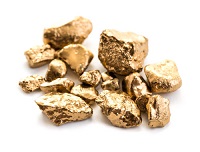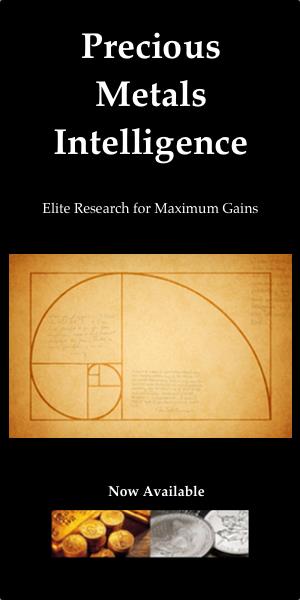Gold Miners: Is the Move Over?
 While gold is up $230 from December for a gain of 22% and silver has added $3.45 for a 25% gain over the same time frame, the real news in the investment world has been the action in the gold and silver miners. Indeed, from the winter lows, the HUI Index of gold and silver mining equities is up an incredible 130%, far outpacing the gains mentioned above in the precious metals themselves.
While gold is up $230 from December for a gain of 22% and silver has added $3.45 for a 25% gain over the same time frame, the real news in the investment world has been the action in the gold and silver miners. Indeed, from the winter lows, the HUI Index of gold and silver mining equities is up an incredible 130%, far outpacing the gains mentioned above in the precious metals themselves.
Is it too late for investors to participate in this move? To attempt to answer that question, in this article we look at the mathematics behind the mining industry and some historic valuation metrics for the gold and silver miners compared to other economic assets.
Mining Leverage Explained
The gains seen in the precious metals miners should be expected due to the leverage these companies enjoy which is based on the mathematics inherent in the business of mining.
How this outperformance works can be illustrated with this hypothetical example. Yamana Gold Corp. owns a deposit of one million ounces of gold in the ground and is able to mine every ounce for $870 per ounce. When they later sell that gold for $1,270 per ounce (at current prices), they will profit $400. Now suppose the price of gold increases to $1,670 within a few years. Assuming the costs of mining stay relatively stable, Yamana now sells each ounce for $800 profit. [Note: we do not own shares in Yamana Gold nor plan to in the immediate future.] We can see that while the price of gold increased by 31% ($1,270 to $1,670), the profits (and therefore share price of the company) would have increased by 100% ($400 to $800 profit per ounce). Thus, an investor can achieve profits well in excess of the actual rise in the price of gold or silver.
More extreme outperformance on a percentage basis will be seen by the companies that add at least one of the following variables to their operations during a rising gold price environment:
- Increased gold production year over year
- Discover a new gold deposit
- Expand an existing gold deposit
- Open a new mine
- Re-open a previously uneconomic mine
- Lower mining cash costs due to operational efficiency
- Merge with an existing mining company
- Be acquired by existing mining company
- Fund expansion without issuing excessive shares
The Gains are Just Beginning
Having alerted readers to nearly the exact bottom in the gold and silver mining sector with our article titled "Trade of the Decade" back in early February, many are now wondering how much further the move can go. Certainly a 130% gain across the large cap gold miners must be too far, too fast. Or is it?
While we agree that the current rate of acceleration cannot continue indefinitely, we wish to make our readers aware that the strength of the move we have seen thus far is nothing short of an impulsive move higher into the sector. And while the first wave of an impulsive move must pause at some point for either a consolidation or moderate correction, impulsive waves of this nature tend to be the forbearers of much longer trends on the verge of development.
For comparison, let us view the price action of the HUI Gold Miners Index at its last major secular low, in the year 2000.
Note that, as shown above, the first 130% move higher in the average was only the initial wave of what went on to become a 640% gain within the first three years of the bottom. In percentage terms, this first wave higher was only 20% of the move that materialized over those first three years.
We thus caution readers who either believe that they missed the entire move or that now is the time to sell all their holdings that this may simply be the first wave higher of a more significant bull market featuring gains many-fold those already witnessed.
Gold Miners vs. Gold Bullion
We anticipate at this point that some readers may question that the current bottom seen across the gold miners is of similar magnitude to that of the year 2000. Does this bottom warrant such an extreme revaluation higher? For these readers, we offer the following two significant valuation metrics by which we can evaluate the gold miners: gold miners versus gold itself and gold miners versus the rest of the US economy.
First, we view the HUI Gold Miners Index versus the price of gold itself. Expressed in ratio form, this chart shows us how many ounces of gold are required to purchase one share in each of the aforementioned gold miners.
As we can see, in 2000, the ratio bottomed at 0.125 ounces of gold required to purchase one share of the HUI Index. Yet astonishingly, at the 2015 bottom, this ratio actually fell to 0.10 - a new all-time low below the 2000 reading. In other words, in 2015, gold miners were cheaper relative to the actual product they extract from the ground than they were 16 years prior when the price of the metal was under $260.
Based on the fact that this metric fell lower than its 2000 value, we can reasonably expect an even more extreme revaluation higher for the gold miners than we saw some 16 years prior.
Gold Miners vs Broad US Economy
The second important metric by which we can value gold miners is in their relation to the rest of the US economy. Similar to how we might value railroads or oil refineries versus the rest of the US economy, this measure gives us a ratio of the value of the gold mining sector compared to all the other industries that make up the largest equity market in the world.
Below we view the HUI Gold Miners Index versus the S&P 500, which contains the 500 largest companies in the US stock market. In ratio form, this chart shows how many shares of the S&P 500 Index are required to purchase one share of the HUI Gold Miners Index.
Here we can see that just last January, the ratio bottomed at 0.05, whereas in the precious metals low of the year 2000, the ratio bottomed slightly lower at 0.03. So while gold miners were still valued marginally higher to the rest of the US economy in 2015 compared to 2000, we must note that these figures are both 91% and 95% below the peak value seen in 2011, respectively.
Since we know that the ratio between real assets (gold miners to S&P 500 companies) cannot go to zero, and with a greater than 90% discount to previous highs seen in both 2000 and 2015, we must strongly favor the hypothesis that the recent bottom seen in the mining sector is of similar magnitude to that seen in 2000.
In other words, both the 2000 and 2015 lows represented major long-term bottoms across the precious metals complex.
Summary
The December-January lows seen in gold and silver were major turning points in world markets. While the gains seen in the metals have been excellent thus far, the leverage effect enjoyed by the gold and silver mining equities has been truly phenomenal.
For investors new to the precious metals, we never recommend placing all of one's capital into the mining equities. There remain numerous financial and psychological reasons to own gold and silver in physical bullion form.
However, those with discretionary capital who are really looking to build significant wealth are encouraged to begin researching the gold and silver equities. While it may seem daunting to buy in after a 130% move, history shows that such a gain may merely be the warm-up for a much more significant move to come over the next few years. When measuring both the gold miners versus the S&P 500, and versus the price of gold itself, the mining equities still have potential for years of gains going forward measuring into the hundreds of percentage points.
A consolidation or correction is due at any time. However, those with a multi-year time horizon should consider using any such weakness to accumulate positions for what should be a significant multi-year move still in its early phases.






















